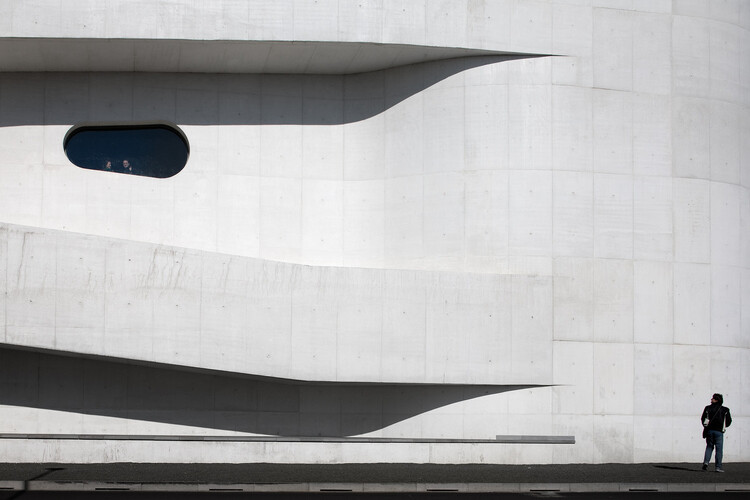
ArchDaily
Articles
The Multiple Facets of the Architect: Exploring the Works of Álvaro Siza Vieira
The Multiple Facets of the Architect: Exploring the Works of Á
ArchDaily
Articles
The Multiple Facets of the Architect: Exploring the Works of Álvaro Siza Vieira
The Multiple Facets of the Architect: Exploring the Works of Álvaro Siza VieiraSaveSaveThe Multiple Facets of the Architect: Exploring the Works of Álvaro Siza Vieiradocument.getElementById('single-content').setAttribute('data-io-article-url', window.location.href);Save this picture!Fundação Iberê Camargo © Fernando Guerra | FG+SGWritten by Helena Tourinho | Translated by Diogo SimõesPublished on January 04, 2024ShareShareFacebookTwitterMailPinterestWhatsappOrhttps://www.archdaily.com/1011353/the-multiple-facets-of-the-architect-exploring-the-works-of-alvaro-siza-vieiraClipboard"COPY"CopyWhen it comes to contemporary Portuguese architecture, the initial association often leans towards tradition. The historical significance of the program, the importance of typologies for the locals, and the construction methods all play a role. These associations are not unfounded, but they are not limiting either. In this context, Portugal boasts a prominent figure who exemplifies this balance: Álvaro Siza Vieira.Siza is the foremost representative of Portuguese architecture. There are many reasons for this distinction. It is not only because he was the first Portuguese architect to receive a Pritzker Prize in 1992 or for the Golden Lion at the Venice Biennale in 2012. It is not solely due to his extensive and prolific career. Above all, his unique and simultaneously universal approach to architecture sets him apart. His involvement on national and international fronts highlights a characteristic likely intrinsic to his nature: the ability to embody many facets within a singular entity, just like his compatriot Fernando Pessoa.+ 9
While his architecture possesses a distinctive and highly individual language, Siza's projects showcase a range of repertoire, solutions, and formal experimentations proportional to the longevity of his career and the contemporaneity regarding current techniques and materials. These characteristics stem from the attitude he adopts towards the profession. Siza does not draw analogies; architecture is an autonomous discipline but by no means isolated. He understands the multidisciplinarity of the field and knows the extent of its reach but does not concede applications or transpositions of other disciplines, like 1960s linguistics or sociology. For him, architecture is realized in the appropriate constructive response to the given problem. It engages in a dialogue with these other fields but manifests itself tectonically through design, construction, and technique.
Save this picture!Fundação Iberê Camargo © Fernando Guerra | FG+SGThe emphasis on the latter point is a significant aspect of his work. The focus on construction methods is integral to what makes each project unique. In Portugal, reverence is shown through respect for tradition and culture. However, in other countries, the distinctive construction methods inform his projects, adapting to the context of everyone involved in the work. This approach provides diverse solutions to be assimilated and expanded in future projects. This architectural stance, balancing the precision of technique with the flexibility of formal and programmatic solutions, is a legacy that Siza Vieira has already passed on to some. The work of Carlos Castanheira follows the same principle.Save this picture!Nadir Afonso Contemporary Art Museum © Fernando Guerra | FG+SGJust as Siza "mentored" Castanheira, he also had his mentors. During his undergraduate studies in Porto, the architecture program underwent a curricular renewal led by Carlos Ramos. This allowed students access to foreign publications showcasing the works of an extensive list of prominent figures in modern architecture, a period coinciding with a totalitarian government in Portugal. Furthermore, Siza was Fernando Távora's student, later becoming a collaborator and colleague. Following what seems like a tradition, Siza became a professor, repeating the cycle that shaped him. Between architectural theory and practice, his references to his predecessors and profound technical knowledge come together, constantly evolving and adapting in his ongoing production.His international involvement was spurred by the economic context in Portugal, which "forced" him to build abroad. However, the foreign experiences brought new techniques and perspectives that undoubtedly influenced his approach to design. Much can be said about the placements, framings, and the variety of forms in his projects. Whether in Portugal or abroad, his architecture is remarkably in harmony with the context, always unmistakably reflecting the essence of Siza.Expo'98 Portuguese National PavilionSave this picture!Expo'98 Portuguese National Pavilion © Pedro Moura Pinheiro via FlickrFundação Iberê CamargoSave this picture!Fundação Iberê Camargo © Fernando Guerra | FG+SGEdifício sobre a Água / Álvaro Siza + Carlos CastanheiraSave this picture!Edifício sobre a Água / Álvaro Siza + Carlos Castanheira © Fernando Guerra | FG + SGMIEC + MMAP / Alvaro Siza + Eduardo Souto de MouraSave this picture!MIEC + MMAP / Alvaro Siza + Eduardo Souto de Moura © João MorgadoNadir Afonso Contemporary Art MuseumSave this picture!Nadir Afonso Contemporary Art Museum © Fernando Guerra | FG+SGLeça Swimming PoolsSave this picture!Leça Swimming PoolsChapel in MiljanaSave this picture!Chapel in Miljana © Miljenko BernfestWohnhaus Schlesisches Tor (Bonjour Tristesse) / Álvaro Siza Vieira + Peter BrinkertSave this picture!Wohnhaus Schlesisches Tor (Bonjour Tristesse) / Álvaro Siza Vieira + Peter Brinkert © via Wikimedia CommonsSaya Park / Álvaro Siza + Carlos CastanheiraSave this picture!Saya Park / Álvaro Siza + Carlos Castanheira © Fernando Guerra | FG+SGFire Station in Santo TirsoSave this picture!Fire Station in Santo Tirso © João MorgadoThe architect was the subject of the documentary SIZA, directed by Augusto Custódio and available on the streaming platform Gallery. ArchDaily is a partner of Gallery for the premiere session of the documentary, which will take place in São Paulo at MASP on December 12, as well as for the global release on December 15, which can be watched live.
Image gallerySee allShow less
ShareShareFacebookTwitterMailPinterestWhatsappOrhttps://www.archdaily.com/1011353/the-multiple-facets-of-the-architect-exploring-the-works-of-alvaro-siza-vieiraClipboard"COPY"CopyAbout this authorHelena TourinhoAuthor•••
#TagsNewsArticlesAlvaro Siza VieiraPortugalAlvaro SizaArtigosPortoPrêmio PritzkerBienal de VenezaArquitetura contemporâneaPrêmioConhecendo A ObraCite: Tourinho, Helena. "The Multiple Facets of the Architect: Exploring the Works of Álvaro Siza Vieira" [O arquiteto múltiplo: conhecendo a obra de Álvaro Siza Vieira] 04 Jan 2024. ArchDaily. (Trans. Simões, Diogo) Accessed .


